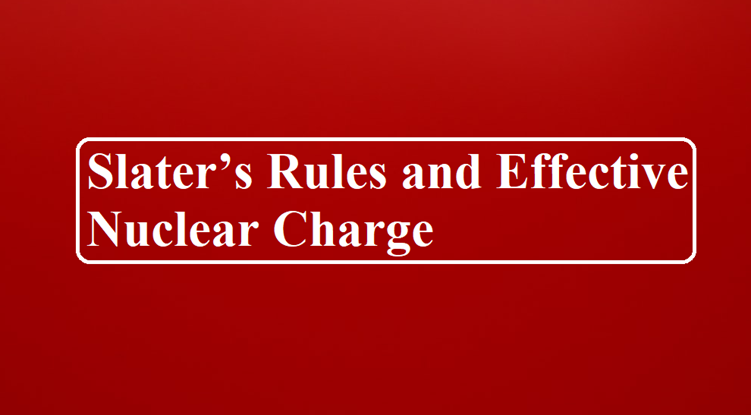Slater’s Rules and Effective Nuclear Charge
Consider an electron in one of the atomic orbitals of a multi-electron atom. Because of the repulsion by other electrons in the same or different orbitals, the nuclear charge felt by this electron will be less than the actual nuclear charge. This electron is said to be screened from the influence of the nuclear charge and the reduced charge felt by the electron is known as The Effective Nuclear Charge (Zeff). The intervening electrons screen the electrons present in the peripheral s, p, d or f orbitals of even the same principal shell to different extents.
The effective nuclear charge for an electron in the configuration of an atom may be calculated with the help of the following correlation
Zeff = Zactual – S
Zeff → Effective Nuclear Charge
Zactual → Actual Nuclear Charge (i.e No. of Electrons)
Where S is the screening or the shielding constant whose magnitude determines the extent to which the electron is shielded or screened by other electrons in the atom from the nuclear charge.
The screening constant is evaluated by the following rules known as Slater’s Rules
Rule 1. The various orbitals are grouped in the order given below, starting from the side of the nucleus.
(1s) (2s 2p) (2s 3p) (3d) (4s 4p) (4d) (4f) (5s 5p), etc.
Rule 2. For an electron in a group of s, p electrons, the value of the screening constant S is the sum of the following contributions
(i) Electrons in the same group shield 0.35, Except 1s, which shields 0.30 for H and He only.
(ii) When n = 2, we use 0.35 for the 1s electrons
(iii) Electrons in the n – 1 group shield 0.85
(iv) Electrons in the n – 2 group shield 1.00
(v) Electrons in nd or nf shield 0.35
(vi) Assign any electrons to the left of the d or f electrons 1.00
(vii) Electrons to the right of the electron of interest do not shield.
Example No 1. What is the effective nuclear charge felt by 1s electron of helium atom?
Ans. The electronic configuration of the helium atom is 1s2
There is one more 1s electron, apart from the electron for which Zeff is to be calculated.
The screening constant, S = 1 × 0.30 = 0.3
Hence, Zeff felt by 1s electron of helium atom = 2 – 0.30 = 1.70
Example No 2. What is the effective nuclear charge felt by a 2p electron of a nitrogen atom? What will be the effective nuclear charge felt by its 1s electron?
Ans. The electronic configuration of the N atom is 1s22s22p3
There are four other electrons in the (2s 2p) group.
Screening constant S for 2p electron = 4 × 0.35 + 2 × 0.85 = 1.40 + 1.70 = 3.10
Zeff felt by 2p electron = Z actual – S = 7 – 3.10 = 3.9
Zeff felt by 1s electron = 7 – 1 ´ 0.3 = 6.7.
Example No 3. What is the effective nuclear charge felt by a 2p electron of fluorine atom?
Ans. The electronic configuration of the F atom is 1s22s22p5
There are 2 electrons in n = 1. There are 7 e in n = 2 but this includes the electron of interest so, subtract 1 leaving 6 electrons.
There are six other electrons in the (2s 2p) group
Screening constant S for 2p electron = 6 × 0.35 + 2 × 0.85 = 1.90 + 1.70 = 3.60
Zeff felt by 2p electron = Z actual – S = 9 – 3.60 = 5.2
Example No 4. Calculate the effective nuclear charge felt by a 3d electron of a chromium atom (Z = 24).
Ans. The grouping of electrons in the Cr atom according to Slater’s rules is
(1s2) (2s22p6) (3s23p6) (3d5) (4s1)
There will be no contribution from the 4s electron.
There are 4 other 3d electrons.
Zeff felt by the 3d electron of Cr atom = 24 – (0.35 × 4 + 1.0 × 18) = 4.60
Slater’s Rules and Effective Nuclear Charge



